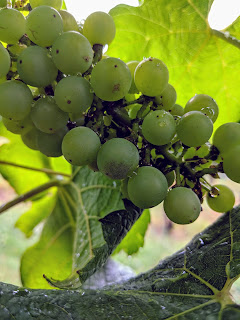It depends on where you are, but in northern VA, we are having relatively “dry” weather this summer. We have some rain events here and there, but overall, the air is humid, but not wet. Such a condition promote powdery mildew development, so, I just want to provide a reminder on powdery mildew management.
Powdery mildew pathogen thrives under shaded condition (i.e., overcrowded canopy). Thus, canopy management is a very important aspect of powdery mildew management.
Chemical management options: Sulfur (FRAC = M2) is an economical option. Copper (FRAC M1) works too, but compared with sulfur, copper seems to be slightly less effective. Other options are: DMI fungicides (e.g., Rally, Elite, Mettle, Rhyme, etc, FRAC 3), Quintec (FRAC 13), Vivando (FRAC 50), Luna Experience (FRAC 7 plus 3), Topguard EQ (FRAC 11 plus 3), Rhyme, Kenja, and Aprovia (FRAC 7), Torino (FRAC U6), etc. Please make sure to rotate FRAC groups. Try to limit the use of a particular FRAC group to twice a season with an exception of FRAC group starts from M.
Fungicide resistance issues: QoI (FRAC 11, e.g., Abound, Flint, etc.) = widespread in VA. I would not count on the QoI material for powdery mildew management. Quintec (FRAC 13) = limited occurrences, but there is a recorded case in VA. There is evidence of DMI-resistant powdery mildew isolates in VA, thus, please do not overuse or rely heavily on DMI products.
If you have an outbreak that cannot stop, please use sulfur or copper (i.e., do not spray the material with FRAC group starts with a number). Also, Kaligreen, Armicarb, and other potassium bicarbonate (FRAC M) are effective; however these materials tend to be expensive. Stylet oil (FRAC M) can be used on on-going powdery mildew too; however, please note that you cannot mix (or use within 14 days) oil and sulfur (the same is true with oil and captan).
